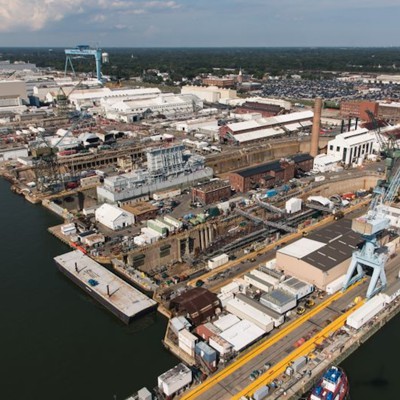NATIONAL HARBOR, Md.—Within just a few months, the country’s largest military shipbuilder aims to have its shipyard employees taking direction from AI.
“By the end of this year, our plan is to have every single person in our manufacturing shops—17 different businesses, basically across 550 acres—doing work based on the output of what AI tells us to go do. At the end of [2026] all of the people working on all of our ships will be directed by what AI tells us to do,” Brian Fields, the chief technology officer for HII’s Newport News Shipbuilding division, said at C3 AI’s federal event on Tuesday. “So we’re jumping in the deep end of the pool… If we don’t do something rapidly, we are not going to supply the Navy with the ships they need.”
HII, which has been leaning into emerging technologies, inked a deal with C3 AI earlier this year to use agentic AI, which uses automation to learn and make decisions once given specific goals, to help the shipbuilder meet its goals of a 20-percent increase in production.
“We have 17 different shops: 2,300 people. They have to do 5,200 jobs a week, and each one of those jobs has 32 different data sources. So you’re talking hundreds of thousands of decisions…to be made by about 100 people in spreadsheets. The results you have are really built on the process you have. And we need a new process,” Fields said.
The push for using AI in shipbuilding comes as the White House and Navy leaders demand faster production times for nuclear-capable submarines.
Stephen Ehikian, C3 AI’s new CEO, said the company’s platform creates a kind of “digital twin” of the shipbuilding process and can run “virtual simulations,” including scenario planning and risk assessment.
“We showed agentic process automation, workflow automation, as well as ability to build actual applications,” Ehikian, who was most recently the acting and deputy administrator for the General Services Administration, told reporters. “The whole market is moving towards seeing actual outcomes. The applications are the most valuable piece of this.”
Newport News plans to use AI to pinpoint production chokepoints in submarine production.
“If all you’re doing is moving data around to try to keep the systems working, I’d much rather automate that, because we got way too many people that are in that side of the business, and I’d rather have them helping us build ships more efficiently,” Fields told reporters.
“The thing that keeps us from building submarines at the pace that they need to be built right now comes down to 17 parts. Seventeen parts drive an enormous increase in submarine build, and those 17 parts come from a foundry that isn’t able to get us the parts to put one piece of complex equipment together. So we’re in the midst right now of using that data and aggressively working with the Navy to go print those parts and radically change how we deliver submarine builds.”
The goal is for AI to pull information from disparate sources including spreadsheets, analytics, accounting and scheduling systems. That analysis will in turn—and over time—help shipbuilders “make the right stuff in the right order to give the ship assembly teams the best chance to deliver the ships on time. And that’s a long process,” Fields said.
And there’s also the challenge of getting the workforce to trust and use the tools.
“When you get down into our shops, there’s a lot of pride about how they do their work,” Fields said during the event. “One of our work streams is process and behaviors, and we’ve put some strong leaders in that to really drive the leadership in those shops to say, ‘We own this; we’re going to get the value out of it.’”

